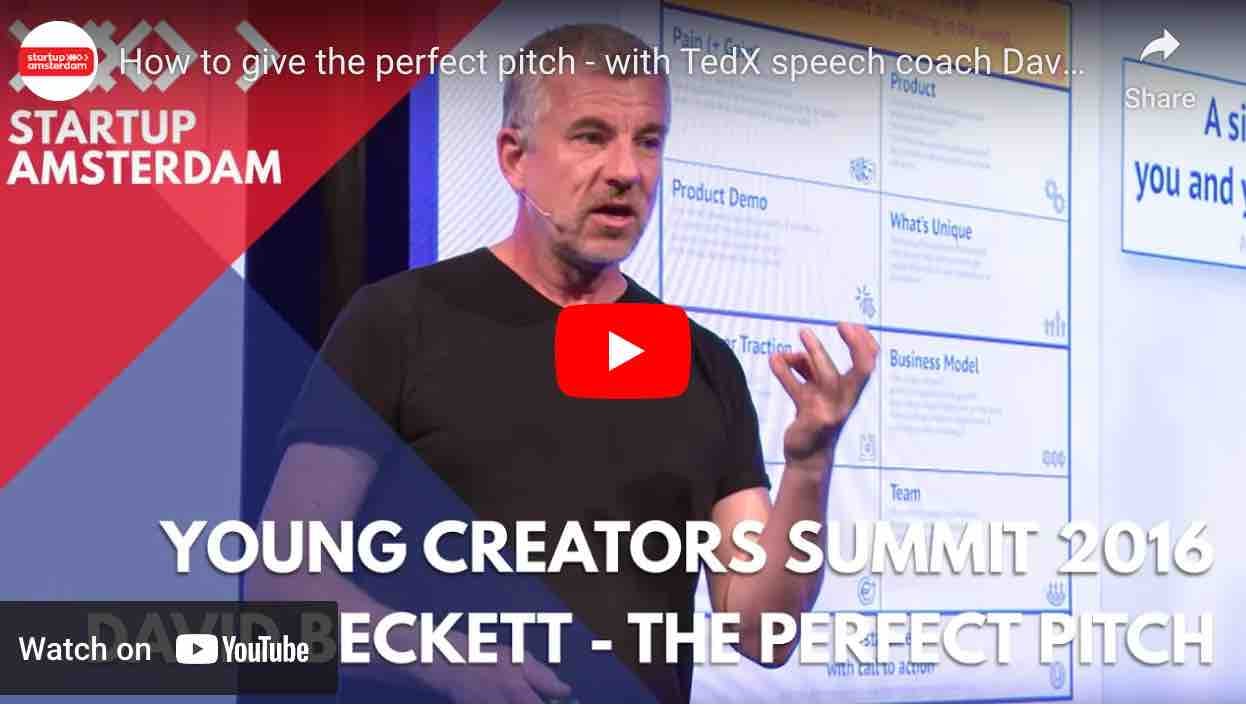Summary
This document provides guidance on creating a pitch deck for the Disrupt phase of an ExO Sprint or other innovation processes, including a recommended pitch structure, goal setting, collaboration tips, and rehearsal advice. It also includes links to videos showcasing examples of successful pitches.
Recommended Pitch Structure
- [ ] Frontpage
- [ ] Problem Statement
- [ ] Massive Transformative Purpose (MTP)
- [ ] The Solution
- [ ] Market Validation
- [ ] Value Proposition
- [ ] Use Case(s)
- [ ] Business Model (with ExO Attributes)
- [ ] Competitive/Unfair Advantages
- [ ] Roadmap to Exponential Growth
- [ ] Call To Action
- [ ] Backup Slides
Align about the Pitch Structure with your organization!
If you pitch to your own organization/business/school, there may be specific content the pitch needs that is not suggested by this pitch structure -or the sequence or structure must be different to comply to company standards. Begin reviewing the structure with senior decision makers as well as innovation teams within your organization to get the structure right before you begin building your pitch deck.
What is the goal of your Pitch?
Initially, you pitch for input/feedback and to learn, not to get funded. This is also the case in the Disrupt Workshop if you are taking part of an ExO Sprint. Later in your process (for example the final Launch Workshop in the ExO Sprint), you will pitch for support, mentoring, funding etc. and that is a different scope for your pitch. Be clear about what you want to accomplish with your pitch before you begin building your pitch deck.
Are your goals SMART? Check here:
A SMART goal is used to help guide goal setting. SMART is an acronym that stands for Specific, Measurable, Achievable, Realistic, and Timely. Therefore, a SMART goal incorporates all of these criteria to help focus your efforts and increase the chances of achieving your goal.
SMART goals are:
-
Specific: Well defined, clear, and unambiguous
-
SMART Goal – Specific (click to toggle/unfold inner content here)
Goals that are specific have a significantly greater chance of being accomplished. To make a goal specific, the five “W” questions must be considered:
- Who: Who is involved in this goal?
- What: What do I want to accomplish?
- Where: Where is this goal to be achieved?
- When: When do I want to achieve this goal?
- Why: Why do I want to achieve this goal?
For example, a general goal would be “I want to get in shape.” A more specific goal would be “I want to obtain a gym membership at my local community center and work out four days a week to be healthier.”
-
-
Measurable: With specific criteria that measure your progress toward the accomplishment of the goal
-
SMART Goal – Measurable
A SMART goal must have criteria for measuring progress. If there are no criteria, you will not be able to determine your progress and if you are on track to reach your goal. To make a goal measurable, ask yourself:
- How many/much?
- How do I know if I have reached my goal?
- What is my indicator of progress?
For example, building on the specific goal above: I want to obtain a gym membership at my local community center and work out four days a week to be healthier. Every week, I will aim to lose one pound of body fat.
-
-
Achievable: Attainable and not impossible to achieve
-
SMART Goal – Achievable
A SMART goal must be achievable and attainable. This will help you figure out ways you can realize that goal and work towards it. The achievability of the goal should be stretched to make you feel challenged, but defined well enough that you can actually achieve it. Ask yourself:
- Do I have the resources and capabilities to achieve the goal? If not, what am I missing?
- Have others done it successfully before?
-
-
Realistic: Within reach, realistic, and relevant in supporting your Massive Transformative Purpose (on short or longer term?)
-
SMART Goal – Realistic
A SMART goal must be realistic in that the goal can be realistically achieved given the available resources and time. A SMART goal is likely realistic if you believe that it can be accomplished. Ask yourself:
- Is the goal realistic and within reach?
- Is the goal reachable, given the time and resources?
- Are you able to commit to achieving the goal?
-
-
Timely: With a clearly defined timeline, including a starting date and a target date. The purpose is to create urgency.
-
SMART Goal – Timely
A SMART goal must be time-bound in that it has a start and finish date. If the goal is not time-constrained, there will be no sense of urgency and, therefore, less motivation to achieve the goal. Ask yourself:
- Does my goal have a deadline?
- By when do you want to achieve your goal?
For example, building on the goal above: On August 1, I will obtain a gym membership at my local community center. In order to be healthier, I will work out four days a week. Every week, I will aim to lose one pound of body fat. By the end of August, I will have realized my goal if I lose four pounds of fat over the course of the month.
-
The Importance of SMART Goal Setting
Often, individuals or businesses will set themselves up for failure by setting general and unrealistic goals such as “I want to be the best at X.” This goal is vague, with no sense of direction.
SMART goals set you up for success by making goals specific, measurable, achievable, realistic, and timely. The SMART method helps push you further, gives you a sense of direction, and helps you organize and reach your goals.
Good luck setting SMART goals for your Sprint initiatives!
Use collaborative online documents
Get everyone in your team (and your coach and others) involved in the creative process of building your pitch. Make sure your pitch deck (document) is an online, collaborative document and make it accessible to everyone involved with user rights for commenting or editing. Consider sharing the deck also with external stakeholders such as your intended end user and others -simply by sharing the same document. Google Docs, Microsoft 360 or other platforms all get the job done! Again, if you are a school student, corporate associate or someone else who must comply with the data privacy policies of your organization, then make sure to use the document/content platform provided by your organization. Avoid sharing content outside of the selected platforms unless your sponsor/manager/teacher/other responsible has given you permission to share your content.
Pitch Rehearsal
It is recommended to rehearse the pitch multiple times with the team, incorporating feedback from each rehearsal. Record the pitch and review it to identify areas that need improvement. It is also a good idea to practice the pitch in front of a small audience to simulate the actual presentation.
During the rehearsal, pay attention to the timing of each section and make sure the pitch fits within the allotted time frame. Each team member should be comfortable with their part and able to deliver it smoothly.
Consider having a backup plan in case of technical difficulties, such as having a printed copy of the pitch deck or a backup device for the presentation.
Remember to be confident and engaging during the pitch, and use visuals and examples to illustrate the team's ideas.
The Perfect Pitch
We are not sure the perfect pitch really exists, but some come really close. Before you build your own, why not set aside some time (1-2 hours) studying the examples and best practices that are presented in the videos below.
Feeling confident already? Sure you can skip and go right to the detailed elements of the pitch structure below. Enjoy either way!


